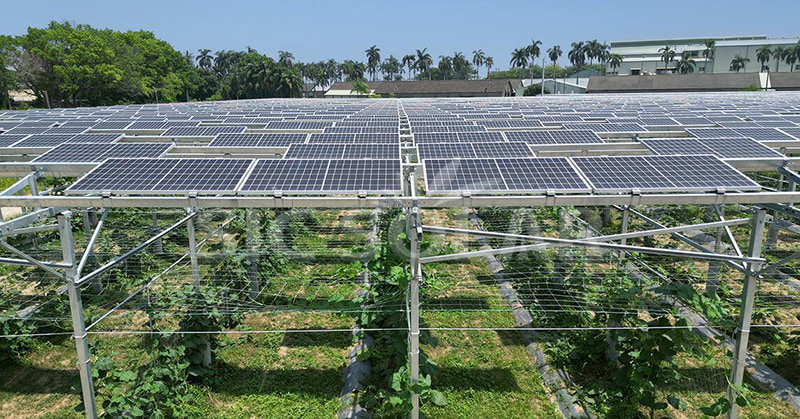Solar farms are large-scale photovoltaic systems designed to harness solar energy and convert it into electricity for use on a commercial scale. Determining the ideal size for a solar farm is a crucial factor, as it impacts the farm’s efficiency, costs, and overall viability.
Factors Influencing Solar Farm Size
When designing a solar farm, the size isn’t a one-size-fits-all choice. The ideal size depends on several factors, including location, energy goals, land availability, and budget.
- Energy Production Goals
- One of the main drivers of solar farm size is the energy production target. Solar farms are typically rated in megawatts (MW), with smaller farms starting around 1 MW and larger projects extending beyond 100 MW. The higher the energy goal, the larger the required land area and the more panels needed.
- On average, a 1 MW solar farm can power around 200-250 homes annually, so scaling up energy production involves significant acreage and equipment.
- Land Availability and Site Suitability
- The available land for a solar farm heavily influences its size. A standard utility-scale solar farm generally needs 4-5 acres per MW, though this can vary based on panel type, spacing, and installation angle.
- Site characteristics like slope, shading, soil quality, and environmental restrictions also play a role. Flat, open areas are ideal as they minimize shading and allow for optimal panel positioning, which affects both the size and productivity of the farm.
- Budget and Funding
- The size of a solar farm is also contingent on the available budget. Larger installations require substantial investment in equipment, land preparation, labor, and maintenance. Although larger farms may benefit from economies of scale, they come with higher upfront costs.
- Government incentives and subsidies can impact the feasible size of a solar farm, as financial support may allow developers to scale up the project more affordably.
- Grid Capacity and Location
- Proximity to the power grid and the grid’s capacity to handle additional electricity are critical when planning the size of a solar farm. Larger farms, producing higher quantities of energy, must be located near substations with enough capacity to manage the power generated.
- In some regions, grid limitations can restrict the feasible size of a solar farm, making it more practical to design smaller farms that are easier to integrate into the existing power infrastructure.
Types of Solar Farms and Typical Sizes
- Small-Scale Solar Farms (1-5 MW)
- Often found on industrial or commercial properties, these smaller farms require around 4-20 acres and are well-suited for companies aiming to offset their energy costs.
- These installations are relatively quick to deploy and usually face fewer regulatory hurdles, making them an efficient solution for localized energy needs.
- Mid-Scale Solar Farms (5-50 MW)
- Mid-scale farms serve larger commercial, industrial, or municipal needs, requiring around 20-250 acres. They provide enough electricity to power small communities or large industrial sites.
- This scale allows for more efficient equipment and labor utilization, making them cost-effective while still delivering significant energy output.
- Utility-Scale Solar Farms (50+ MW)
- Utility-scale farms are massive projects that supply electricity directly to the grid, often covering several hundred to thousands of acres. These farms generate significant energy, meeting the needs of thousands of homes and businesses.
- Although more complex to develop, large utility-scale farms benefit from economies of scale, reducing per-MW costs for equipment, installation, and maintenance.

How SIC Solar Supports Optimal Solar Farm Development
SIC Solar, a leading provider of photovoltaic mounting solutions, plays an essential role in ensuring that solar farms of all sizes are built efficiently and securely. Here’s how their products contribute to optimal solar farm installation:
- Customizable Mounting Systems: SIC Solar offers a range of mounting solutions designed to fit various site conditions, from flat terrains to uneven ground. Their mounting systems can be tailored to match the needs of different-sized farms, ensuring efficient space use and maximizing energy capture.
- Durable and Weather-Resistant Materials: Solar farms, especially utility-scale ones, are exposed to diverse weather conditions. SIC Solar high-quality mounting systems, made from corrosion-resistant materials like aluminum and stainless steel, provide long-lasting support that withstands harsh environmental conditions.
- Ease of Installation: Time efficiency is critical for solar farm developers, and SIC Solar mounting systems are engineered for rapid installation, helping reduce labor costs and accelerating project timelines. This flexibility is particularly beneficial for large projects where time and cost savings are paramount.
- Adaptability for Scaling Projects: SIC Solar solutions support modular and scalable designs, allowing for expansions in mid- and utility-scale farms as energy demands grow. This adaptability helps developers make strategic choices about the size of the solar farm while planning for future growth.
The Future of Solar Farm Sizing and Technology
As solar technology advances, the energy output per panel continues to improve, making it possible to achieve higher energy goals on smaller footprints. Innovations like bifacial panels and solar tracking systems, which SIC Solar supports with compatible mounting solutions, allow farms to capture more energy from the same land area. These improvements may lead to smaller, more efficient solar farms, further reducing the land and budget requirements for large-scale solar power generation.
Determining the best size for a solar farm is a balance of energy goals, land availability, budget, and logistical considerations like grid proximity. From small-scale commercial projects to expansive utility farms, each setup requires thoughtful planning and reliable components to achieve optimal performance. By using high-quality mounting systems from providers like SIC Solar, developers can ensure that their solar farms are built to last and deliver consistent, efficient energy output for years to come.